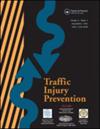Investigating crash mechanisms: Occupational factors among traditional and ride-hailing taxi drivers
IF 1.9
3区 工程技术
Q3 PUBLIC, ENVIRONMENTAL & OCCUPATIONAL HEALTH
引用次数: 0
Abstract
Objective
Taxi crashes rank second highest among all commercial vehicle crashes, primarily due to driver factors. Conducting driver occupational analysis is imperative for safeguarding the safety of taxi operations.
Methods
This study used a survey questionnaire among 4,383 traditional and ride-hailing taxi drivers in China, analyzing 25 crash-related factors from an occupational standpoint. Subsequently, a multiple indicators multiple causes (MIMIC) model was devised to delve into the mediating effects and crash causation mechanisms.
Results
The distinct influences of various factors on crash occurrence between traditional and ride-hailing taxi drivers are emphasized. The findings show that ride-hailing taxi drivers tend to be younger, have higher education levels, and have a higher proportion of part-time employment compared to traditional taxi drivers. They also report lower average income and management fees, shorter average driving hours, fewer severe sleep issues and fatigue levels, and lower crash rates. Further analysis uncovers that for traditional taxi drivers, gender and 5 factors directly affect crashes, and age and 7 factors indirectly affect crashes through unsafe driving behaviors. For ride-hailing drivers, occupational status and 5 factors, plus management fees and 9 others, play significant roles in safety. Overall, the influence of individual attributes on crash incidence varies between taxi drivers, with age and occupational status being the most significant factors. Additionally, the immediate economic burden has a stronger direct impact on crashes for both driver types. Furthermore, intensity-related factors, such as fatigue and extended continuous driving periods, contribute to unsafe driving behaviors and increase crash risk indirectly.
Conclusions
With the use of targeted prevention policies proposed in this study, significant strides can be made in reducing the incidence of taxi crashes and enhancing overall transportation safety.
碰撞机制研究:传统出租车司机与网约车司机的职业因素。
目的:出租车事故在所有商用车事故中排名第二,主要是由于驾驶员因素。进行司机职业分析是保障的士安全营运的必要条件。方法:对4383名中国传统出租车司机和网约车司机进行问卷调查,从职业角度分析25个事故相关因素。随后,我们设计了一个多指标多原因(MIMIC)模型来深入研究崩溃的中介效应和因果机制。结果:强调了各种因素对传统出租车司机和网约车司机碰撞发生的显著影响。研究结果显示,与传统出租车司机相比,网约车司机往往更年轻,受教育程度更高,兼职比例更高。他们的平均收入和管理费用也更低,平均驾驶时间更短,严重的睡眠问题和疲劳程度更少,碰撞率也更低。进一步分析发现,对于传统出租车司机,性别和5个因素直接影响事故,年龄和7个因素通过不安全驾驶行为间接影响事故。对于网约车司机来说,职业地位和5个因素,加上管理费和其他9个因素,对安全起着重要作用。总体而言,个体属性对事故发生率的影响在出租车司机之间存在差异,年龄和职业状况是最显著的影响因素。此外,直接的经济负担对两类司机的撞车事故都有更大的直接影响。此外,疲劳和长时间连续驾驶等强度相关因素也会间接增加不安全驾驶行为,增加碰撞风险。结论:采用本研究提出的有针对性的预防政策,可以在减少出租车碰撞发生率和提高整体交通安全方面取得重大进展。
本文章由计算机程序翻译,如有差异,请以英文原文为准。
求助全文
约1分钟内获得全文
求助全文
来源期刊

Traffic Injury Prevention
PUBLIC, ENVIRONMENTAL & OCCUPATIONAL HEALTH-
CiteScore
3.60
自引率
10.00%
发文量
137
审稿时长
3 months
期刊介绍:
The purpose of Traffic Injury Prevention is to bridge the disciplines of medicine, engineering, public health and traffic safety in order to foster the science of traffic injury prevention. The archival journal focuses on research, interventions and evaluations within the areas of traffic safety, crash causation, injury prevention and treatment.
General topics within the journal''s scope are driver behavior, road infrastructure, emerging crash avoidance technologies, crash and injury epidemiology, alcohol and drugs, impact injury biomechanics, vehicle crashworthiness, occupant restraints, pedestrian safety, evaluation of interventions, economic consequences and emergency and clinical care with specific application to traffic injury prevention. The journal includes full length papers, review articles, case studies, brief technical notes and commentaries.
 求助内容:
求助内容: 应助结果提醒方式:
应助结果提醒方式:


